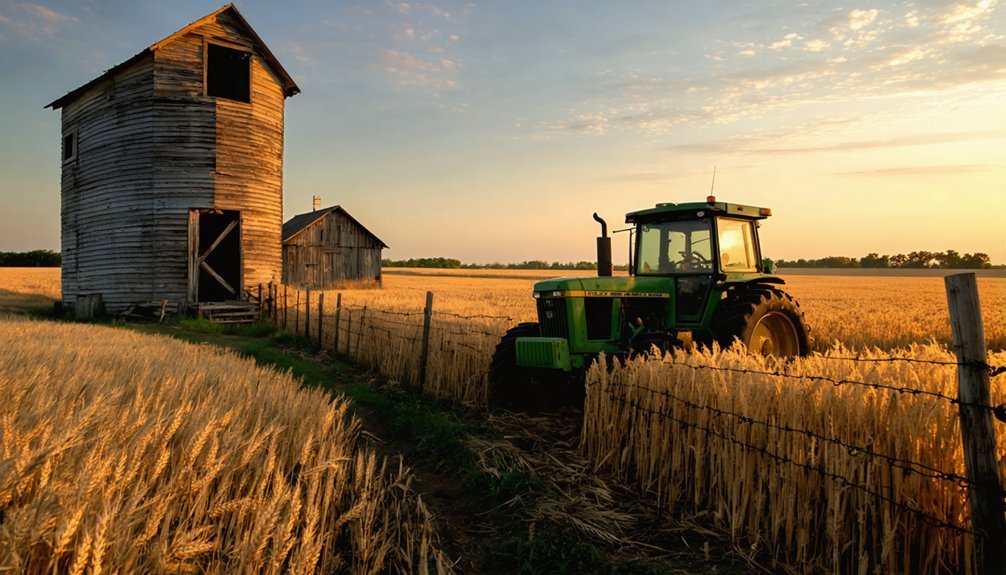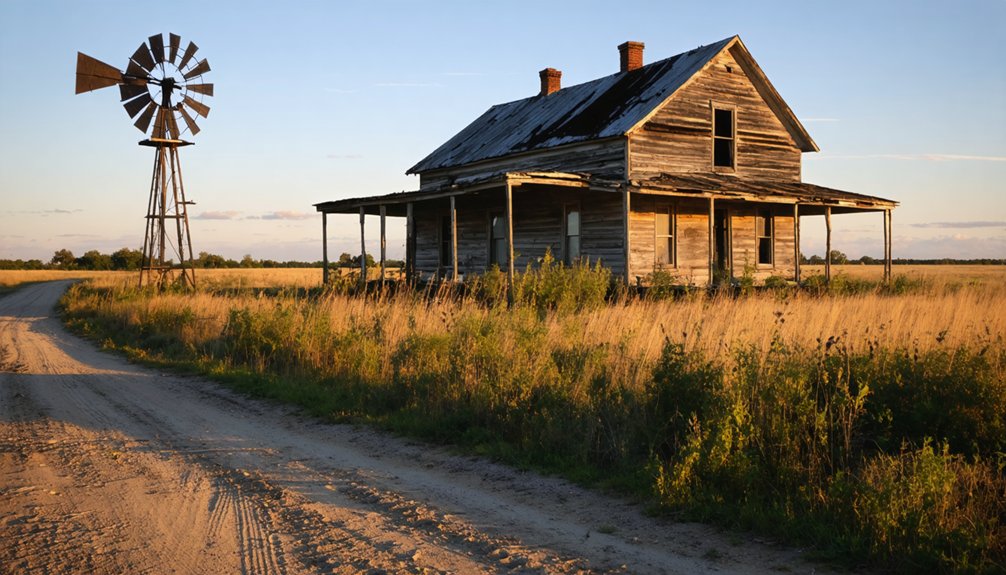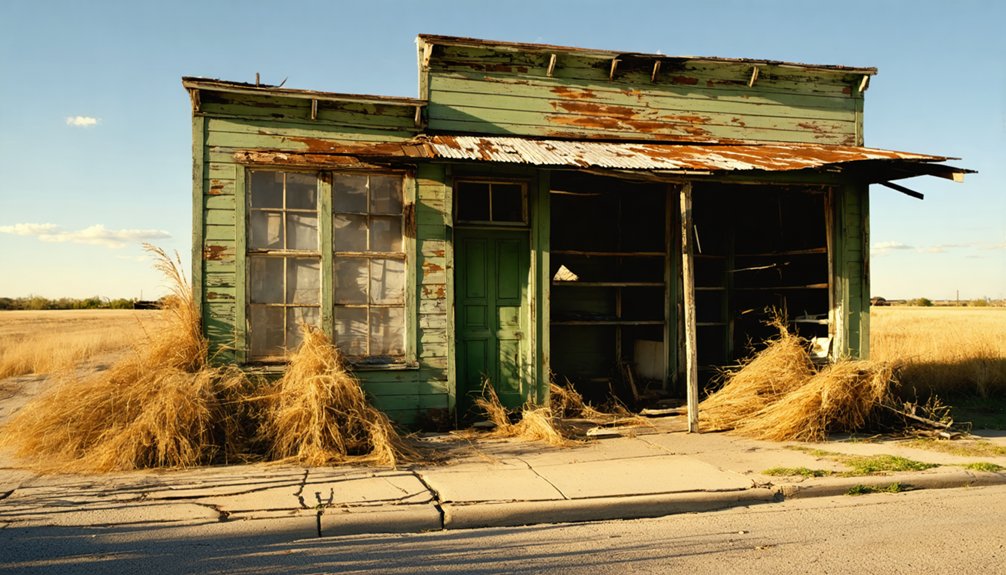You’ll find Macksville’s remains scattered across West Texas’s arid landscape, where it once thrived as a farming settlement established in 1910 by J.M. McCurry. The town transformed during the oil boom but failed to sustain its prosperity due to poor resource management. Today, you can explore the ghost town‘s stone foundations, old cistern, and rusted remnants of its commercial heyday, though you’ll need detailed maps and 4WD access. The site’s rich history holds many more untold stories.
Key Takeaways
- Established in 1910 by J.M. (Mack) McCurry, Macksville thrived initially through farming, ranching, and later oil production before becoming a ghost town.
- The town’s remains include ruins of the post office, courthouse, Hicks-Cobb store, and the John Ruckman house.
- Macksville’s decline followed oil production decrease and agricultural mechanization, leading to complete depopulation and ghost town status.
- Located near major U.S. Highway corridors and the Frio River, the site now requires 4WD access through unpaved roads.
- Natural vegetation has reclaimed most structures, leaving only scattered foundations, cellar depressions, and rusted fragments visible today.
The Origins of a Lost Community
While many Texas ghost towns emerged during the late 19th century‘s westward expansion, Macksville developed as a strategic settlement shaped by the era’s industrialization and transportation needs.
Similar to Plemons Crossing, the town’s location was carefully chosen near crucial transportation routes, likely centered around railroad access or river crossings that proved essential for early settlers and commerce.
The community dynamics reflected the diverse mix of native-born Americans and immigrant populations who were drawn to opportunities in mining, agriculture, or railroad work.
Cultural influences shaped distinct neighborhoods as European and Middle Eastern laborers settled alongside American-born residents, creating a vibrant mix of businesses and services, much like the separation between immigrant-owned businesses in Mingus.
Like many Texas settlements of its time, Macksville’s founding revolved around specific economic activities that promised growth and prosperity for its pioneering residents.
Life in Early Macksville
As settlers established themselves in early Macksville, daily life centered around dawn-to-dusk labor that shaped the community’s character.
You’d find men working the cotton fields and tending livestock, while women managed domestic duties and smaller farming tasks. This clear labor division helped the settlement thrive despite harsh frontier conditions. Many families received 177 acres for farming to establish their homesteads. Early transportation relied heavily on cedar getters who navigated the river systems.
Community cooperation defined the town’s development, with homes often serving multiple purposes as post offices and stores.
You’d see neighbors gathering at the Free Methodist church, which served as both a spiritual center and social hub.
The blacksmith shop and grain elevator became essential infrastructure points, marking the town’s evolution from cattle to grain production.
When you visited early Macksville, you’d witness a hardworking community where every interaction served a practical purpose.
Economic Rise and Stagnation
Like many West Texas settlements, Macksville’s fortunes transformed dramatically when prospectors struck oil in the region. You’d have seen workers and speculators flood the area, bringing rapid growth as businesses sprang up to serve the booming population.
Poor resource management proved to be Macksville’s downfall. The town’s economy relied almost entirely on oil extraction, without pursuing economic diversification that might’ve guaranteed long-term stability. When oil production declined, jobs disappeared, triggering a mass exodus of workers. Similar to Best, Texas, which saw its population plummet from 3,500 to 300 by 1945. The lack of alternative industries sealed the town’s fate. The town’s control tactics mirrored those of Thurber, with armed guards patrolling to maintain strict oversight of the workforce.
Infrastructure challenges compounded the problems. While early growth brought basic services and housing, the town struggled with inadequate law enforcement and municipal facilities.
As revenues dropped, businesses shuttered, and public services vanished, leaving Macksville to join the ranks of Texas ghost towns.
Geographic Features and Layout
Nestled in the northwest corner of its county, Macksville occupies a stretch of arid West Texas terrain characterized by sparse vegetation and rocky outcrops. The town’s geographic significance stems from its strategic location near major U.S. Highway corridors and the Frio River to the north.
Similar to Penwell’s oil boom, this area experienced significant development during petroleum discoveries in the region. Like many towns along Farm-to-Market Roads, Macksville remained accessible through maintained roadways. The terrain characteristics you’ll find here shaped the town’s development, with its layout reflecting adaptation to the natural landscape:
- Sandy, loamy soil supported ranching operations and oil drilling infrastructure
- Flat to gently rolling topography enabled straightforward rail and road construction
- Limited water resources, apart from small creeks, influenced settlement patterns
You’ll notice the town’s buildings follow a loose grid pattern, with commercial structures concentrated along transportation routes and residential areas on the periphery, all surrounded by scattered oil field equipment.
Notable Structures and Landmarks
The historic remains of Macksville tell a compelling story through its weathered structures and architectural remnants.
You’ll find the old post office and courthouse standing as representations to the town’s civic life, while the three-story house showcases early settler architecture.
Ghost town tourism centers around the Hicks-Cobb general store and W.W. Cole Building, which reflect the town’s commercial heyday. The site has historical significance like Medicine Mound, where Native American ceremonies were performed on dolomite hills. Visitors can enjoy ax throwing activities among the historic buildings.
Historic preservation efforts have maintained several key structures, including the John Ruckman house ruins and various old west period buildings.
You can spot stone chimneys, foundations, and an old cistern that highlight daily life in early Macksville.
The former gas station, with its rusty pumps, and remnants of industrial structures paint a picture of a once-thriving community.
Placards and monuments throughout the site provide historical context for visitors.
Transportation Links and Isolation
While many Texas towns thrived with railroad connections in the early 20th century, Macksville’s lack of direct rail service proved devastating to its survival.
The town’s transportation challenges were compounded by its remote location in north-central Texas, where unpaved roads and primitive trails made travel difficult year-round.
The economic isolation faced by residents included:
- Limited access to markets for agricultural goods, with horse-drawn wagons being the primary means of transport
- Absence of stagecoach routes and postal services that typically connected rural communities
- Distance from navigable waterways that could have provided alternative shipping options
You’ll find that Macksville’s disconnection from major trade corridors ultimately led to its downfall, as residents struggled to access essential services and commercial opportunities.
Today, only rural county roads reach the ghost town site.
Agricultural Legacy and Impact

Agriculture shaped Macksville’s identity from its 1910 establishment, with pioneer J.M. (Mack) McCurry leading early farming developments that defined this Comanche County settlement.
You’ll find that agricultural traditions centered on mixed farming and ranching, with local farmers growing wheat, corn, and sorghum while raising cattle on family-operated lands.
The community’s resilience was tested by environmental challenges, including devastating droughts of the Dust Bowl and 1950s.
These hardships, combined with the Great Depression and changing agricultural practices, gradually eroded Macksville’s farming population.
Economic upheaval and agricultural modernization steadily diminished the once-vibrant farming community of Macksville.
While the town’s social fabric once thrived on shared agricultural activities and community gatherings, mechanization and economic pressures ultimately led to its decline.
Today, you’ll see mostly ranchland where this farming village once stood.
The Last Businesses Standing
As farming activity dwindled in Macksville, its commercial landscape transformed from a bustling hub to scattered remnants of past enterprise.
The ghost town dynamics followed a familiar pattern, with business remnants gradually disappearing or being repurposed by the mid-20th century.
The town’s commercial decline is evident in these key changes:
- Original storefronts were either demolished or repurposed, erasing the physical traces of the town’s retail history.
- Agricultural supply stores that once supported the cotton farming community ceased operations entirely.
- The post office, a crucial community hub, shut down in the 1930s alongside other essential services.
You’ll find that Macksville’s story mirrors many Texas ghost towns, where the last businesses standing were typically retail or service-oriented establishments before the final population collapse.
Population Patterns Through Time

Following common settlement patterns of Texas ghost towns, Macksville’s population likely experienced its initial growth during the late 1800s when economic opportunities and infrastructure development attracted settlers to the region.
You’ll find that the town’s population, like many similar communities, began declining in the twentieth century as changing economic conditions and transportation routes redirected growth elsewhere.
Today, Macksville stands among the hundreds of Texas ghost towns with zero permanent residents, though it remains marked on maps as a memorial to its past population.
Early Settlement Growth Trends
During the early 1900s, Macksville emerged as a small but steady agricultural settlement, with its population growth reflecting broader patterns of rural Texas development. The settlement dynamics centered around farming and ranching, as families moved to the area seeking fertile land and new opportunities. Rural migration patterns showed most newcomers arrived from neighboring states, drawn to Macksville’s agricultural prospects.
Key characteristics of Macksville’s early growth included:
- A stable community foundation built around essential services like post offices and general stores
- Steady population increases driven by farming and ranching opportunities
- Strong ties to surrounding agricultural areas that supported the town’s development
The settlement’s growth remained modest but consistent through its early decades, maintaining enough residents to support basic community services while preserving its rural character.
Twentieth Century Population Decline
While Texas experienced substantial urban growth throughout the twentieth century, Macksville followed a declining trajectory common to many rural settlements.
You’ll find Macksville’s story mirrors the wider pattern of population migration that transformed the state’s rural landscape. As agricultural mechanization reduced farming jobs and oil boom-bust cycles created economic instability, residents increasingly sought opportunities in growing urban centers.
The town’s decline accelerated during the mid-1900s, reflecting broader economic shifts that affected similar communities across Texas.
Like many rural settlements, Macksville couldn’t sustain its population as industrial and service sector jobs concentrated in cities. By the latter half of the century, the settlement joined the increasing number of Texas communities experiencing persistent out-migration, ultimately leading to its ghost town status.
Modern Era Resident Count
Today’s Macksville stands completely abandoned, with zero permanent residents recorded in modern population counts. This once-active Texas settlement now exemplifies ghost town culture, joining numerous other rural communities that couldn’t sustain their populations against the tide of urbanization.
While Texas’s major cities continue explosive growth, Macksville’s history reflects a different reality you’ll find in many rural areas:
- The surrounding region shows consistent population decline, with nearby rural counties maintaining fewer than 3,000 residents.
- Modern infrastructure and services are nonexistent, making permanent settlement impractical.
- County-level demographic data confirms the area’s ghost town status, with no signs of population rebound.
You won’t find Macksville in recent census records or population databases, as it’s now classified purely as a historical site rather than a living community.
Modern Day Remnants and Access
Little remains of Macksville’s once-bustling community, with only scattered foundations, cellar depressions, and rusted metal fragments marking its former existence.
Natural vegetation has reclaimed most of the site, obscuring many historical remnants beneath its growth.
Site accessibility requires careful planning, as you’ll need to navigate unpaved rural roads that often demand a 4WD vehicle.
You won’t find paved highways or clear signage leading to Macksville, so bring GPS coordinates and detailed maps.
For visitor preparedness, pack essential supplies – there’s no cell service, water, or facilities on-site.
You’ll encounter rugged terrain and potential wildlife, so inform others of your travel plans.
Remember that portions of the site may lie on private property, requiring landowner permission for access.
Frequently Asked Questions
Are There Any Paranormal or Ghost Stories Associated With Macksville?
You won’t find documented ghost sightings or haunted locations in Macksville’s records. Unlike other Texas ghost towns, there aren’t any verified paranormal accounts or local folklore about supernatural activity here.
What Natural Disasters or Extreme Weather Events Affected Macksville’s History?
You won’t find records of major disasters hitting Macksville. While regional drought effects likely challenged local farmers and flood impacts occurred elsewhere in Texas, no specific extreme weather events directly shaped the town’s decline.
Did Any Famous Outlaws or Historical Figures Pass Through Macksville?
You won’t find evidence of any famous outlaws or historical figures passing through Macksville. While outlaws roamed Texas ghost towns, there’s no documented proof they ever visited this particular settlement.
What Native American Tribes Originally Inhabited the Macksville Area?
Like scattered mesquite seeds across the South Texas Plains, the Coahuiltecan peoples were your area’s original inhabitants, carrying rich cultural heritage through their hunter-gatherer tribal traditions before Apache and Comanche arrival.
Were There Any Significant Archaeological Discoveries Made Around Macksville?
You’ll find major archaeological findings near Macksville at the Gault Site, where over 2.6 million historical artifacts reveal human settlements dating back 20,000 years, including ancient projectile points and America’s oldest known art.
References
- https://mix941kmxj.com/the-strange-sad-story-of-a-texas-ghost-town-youll-never-visit/
- https://mix931fm.com/cherokee-county-ghost-towns/
- https://www.youtube.com/watch?v=phjUE19A8HM
- https://texashighways.com/travel-news/four-texas-ghost-towns/
- https://www.ghostsandgetaways.com/ghost-towns
- https://www.southernthing.com/ruins-in-texas-2640914879.html
- https://www.tshaonline.org/handbook/entries/macksville-tx
- https://en.wikipedia.org/wiki/List_of_ghost_towns_in_Texas
- https://www.youtube.com/watch?v=PsuLwAQ12QI
- https://www.thestoryoftexas.com/discover/campfire-stories/frontier-folk



